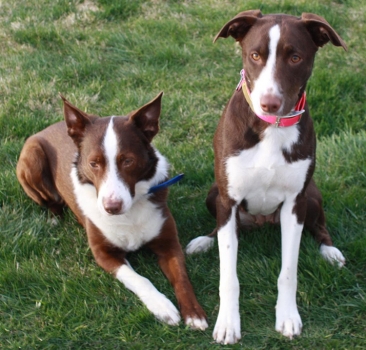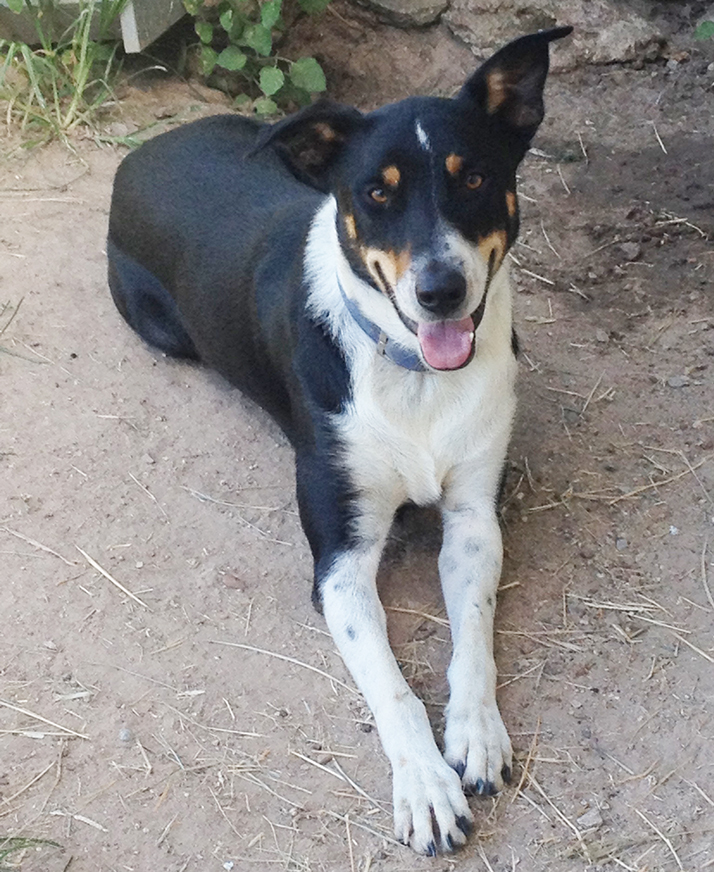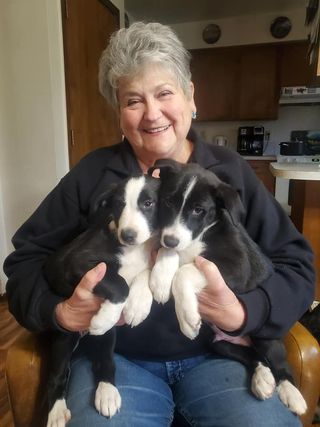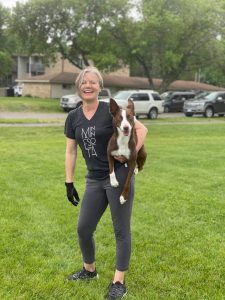The McNab Shepherd
Meet an American breed with a Scottish past
By Carlotta Cooper

Geneaology is a popular pastime. Lots of people love to trace their ancestors and relatives, learning about their family history. When I started looking into my mother’s family, maybe it’s not surprising that I found dog folk. More specifically, I found Alexander McNab, the man credited with developing the McNab Shepherd.
The McNab Shepherd is not yet recognized by the American Kennel Club or other kennel clubs, but if you have herding dogs or if you’re from northern California, you may be familiar with the breed. McNabs are also known as the McNab collie, McNab dog, McNab cattle dog and so on. They are sometimes mistaken for Border Collies, but recent DNA testing shows that there is a clear difference. McNabs now have a founding registry, and at some time in the future they may become a recognized breed.

I had heard about the dogs for years because of their name, which was my mother’s maiden name. Any time I Googled for information about my mother’s family, the dogs cropped up in the hits. Last year, on the clan Facebook page (the McNab family is Scottish, of course), a woman posted about her ancestor in northern California and told some of the story of the dogs. I was hooked.
(McNab is a troublesome name. My mother’s family always spelled it “McNabb,” but some people spell it McNab or MacNab or MacNabb. Some people spelled it different ways at different times. Sometimes it depended on how the census-taker felt like spelling it. It’s all the same family. The same is true for many Scottish “Mc” names. For Alexander McNab and the McNab Shepherd, these names usually appear to be spelled “McNab.”)
The story of the McNab Shepherds goes something like this: As a young man, Alexander McNab started out as a pattern cutter in Glasgow. He appears to have been successful at virtually everything in his life and soon opened his own pattern business. This was also the time period when the daguerreotype, the early form of photography, was coming into vogue. McNab became one of the first and most successful commercial photographers in Scotland, opening photography businesses with some 30 employees in Glasgow and Edinburgh.
By the mid-1860s (when McNab was in his 40s), he was ready to take his wealth and his growing family to new pastures. Those new pastures were in northern California, where he bought land that would eventually total some 10,000 acres.
McNab had the intention of raising sheep on his land in Mendocino County. He first brought some long-haired sheepdogs with him to work the sheep, but they didn’t do well in the climate and terrain. Next, an attempt to herd 3000 head of sheep without dogs was a disaster.
McNab made several return trips to Scotland (where his photography business was still operating) to buy the kind of dogs he needed. He went to sheepman Bruce McInsey in the Grampian Hills to purchase good sheepdogs. The dogs he purchased have been called “Scotch Fox collies.” This is possibly an old term used to describe old-time farm collies in Scotland, where collies are virtually a landrace breed. It’s hard to pin them down, but they appear in the background of several herding breeds such as the Border Collie and the Kelpie. The Fox collies provided the basis for McNab’s breeding program. He also found that he liked the herding dogs used by Basque immigrants to California, so they were also included in his breedings.
 The dogs he bred proved to be well adapted to the California climate, intelligent, and able to herd both cattle and sheep. They could withstand heat, burrs, foxtails and rugged terrain. They could herd from the head or nip at heels. They were highly intelligent, easy to train, and able to work more independently than many herding dogs. They were also good family dogs.
The dogs he bred proved to be well adapted to the California climate, intelligent, and able to herd both cattle and sheep. They could withstand heat, burrs, foxtails and rugged terrain. They could herd from the head or nip at heels. They were highly intelligent, easy to train, and able to work more independently than many herding dogs. They were also good family dogs.
It wasn’t long before his dogs were highly sought after in Mendocino, Napa, Sonoma and Marin counties – the Redwood Empire. If someone mentioned “collie” or “shepherd” in the area, they likely meant a McNab dog. The Noonan Meat Company, based in the area, further popularized the dogs by using them when they herded cattle down College Avenue from the Southern Pacific stockyard in Santa Rosa.
Alexander McNab passed away in 1901 at the age of 82, leaving his ranch and holdings to his children. His son, attorney John Liddle McNab, who would become a U.S. district attorney, was able to consolidate the ranch and gave a boost to breeding the dogs. Alexander had periodically brought more dogs from Scotland to the ranch to breed with his dogs. This was a practice continued by John Liddle McNab.
By this time there were many people in the region who had McNab Shepherds. Other people were breeding the dogs, but there was no registry. Despite this fact, the dogs were working dogs and many of the people who bred them were careful to breed to other McNab dogs to keep the desired traits.
However, by the 1960s, northern California was changing. The large land holdings were being sold and split up for development. Even the McNab Ranch was sold. Three wineries now sit on the land that Alexander McNab and his family homesteaded. The area is still called the McNab Valley.
As for the McNab Shepherd, they remained something of a local hidden treasure for part of the 20th Century, with some dedicated breeders. The breed has survived and even prospered in the last 30 years. The dogs are now living in homes throughout the United States and even in some other countries.
McNabs have always had a good reputation as herding dogs. Today they are becoming popular for agility and other dog sports. They are competing in dock diving, disc dog, herding competitions, lure coursing, dog sledding, skijoring and flyball, along with barn hunt and nose work. Some ranchers are also competing in ranch-dog herding competitions.
They are also proving successful as search and rescue dogs and even as service dogs.
In 2014 breeders and enthusiasts set up a founding registry for the breed: the McNab Shepherd Registry (www.mcnabshepherdregistry.com/). One of the first actions of the registry was to work with Mars Veterinary/Wisdom to do DNA testing on a large number of dogs from across the United States to determine if a unique McNab Shepherd genetic signature could be identified. DNA results showed that the breed could indeed be identified. The tested dogs were also evaluated for certain physical traits along with over 100 disease-causing genetic mutations to help establish a baseline for the population of McNab dogs.
Today, in order for a dog to be registered as a McNab Shepherd, a Wisdom Panel 4.0 test must be submitted along with a DNA profile to make sure the dog has the genetic markers to be a McNab. Dogs produced from inbred matings are not eligible for registration (brother/sister, father/daughter, mother/son).
The registry also created a breed standard: www.mcnabshepherdregistry.com/dog/breed-standard/. Since McNabs have always been a working breed, the standard is very generous with its description in some areas. Although the dogs have not been bred for a standardized appearance in the past, they are often easy to recognize once you have seen them.
Here is a brief overview of the standard with some of the key points.
The standard describes the dog as fast, alert, and intelligent – anxious and able to work livestock under the direction of its master. They should be keen and responsive. McNabs are a medium-sized breed, 18 to 25 inches at the withers and weighing 40 to 70 pounds. They are black, red or blond. Many dogs have white trim. All combinations of colors and markings are acceptable. The gait should give the impression of being able to move at great stealth and speed.
 The coat is short and smooth. It’s straight, sometimes slightly wavy. The top coat has a fine texture; the undercoat is soft and short. Occasionally the hind legs and ears have some feathering.
The coat is short and smooth. It’s straight, sometimes slightly wavy. The top coat has a fine texture; the undercoat is soft and short. Occasionally the hind legs and ears have some feathering.
The tail is moderately long. Some dogs have naturally bobbed tails. Docking is allowed. (As you see, the standard is generous.)
The feet are cat-like with deep pads and tight, well-arched toes. (One of the things that all sources on the McNab dogs agree about right back to the beginning are their cat-like feet.)
The body is slightly longer than tall. McNabs are athletic in appearance with well-sprung ribs and a deep, rather broad chest. The loin is deep and muscular, not tucked up. The croup slopes gently to the set on of the tail.
The forelegs are straight and parallel viewed from the front. From the side, the pasterns are slightly sloping. The bone is strong but not coarse.
The shoulders are well laid back. The elbows are held close to the body.
The neck is strong and muscular, of good length. It is slightly arched at the crest and broadens as it merges with the shoulders.
The ears are medium in size. They are broader at the base and taper toward the tips. They can be drop, semi-erect or prick ears. They don’t have to match. McNabs use their ears sensitively.
The eyes are set wide apart, moderate in size, and oval in shape. They are dark brown or amber in color. Blue eyes sometimes appear, but breeders shouldn’t try to breed for them. The expression is mild, keen, and intelligent.
The muzzle tapers to the nose, moderately and strong. It is approximately the same length as the skull.
The head has a fairly broad skull with no prominence of the occiput. The stop is well-defined. There is no fullness in the cheeks.
 In temperament, McNabs bond tightly to their families and even to other pets in the family. They can be vigilant guard dogs and have a sharp sense of territory, according to McNab sources. While they can be very sensitive, they tend to be more tenacious and territorial than some other herding breeds.
In temperament, McNabs bond tightly to their families and even to other pets in the family. They can be vigilant guard dogs and have a sharp sense of territory, according to McNab sources. While they can be very sensitive, they tend to be more tenacious and territorial than some other herding breeds.
McNabs can be assertive and demanding, so they require an owner who understands positive training methods. These dogs can push back against someone who tries to bully them. Like other herding dogs, McNabs are highly intelligent, and they enjoy having a job or training that keeps their mind busy. They need mental as much as physical stimulation. They have tremendous endurance so lots of exercise is important. However, McNabs do make very good family dogs. Many people speak of the McNab’s love for children. They will herd children, like some other herding breeds. They can have definite ideas about what is and isn’t allowed in the home at times. But as long as these dogs have their needs met, they are more than happy to settle down and curl up next to you at home.
Bred as working dogs, McNabs are still used for ranch work today. They have a loose-eyed herding style so they can be more independent than some other herding breeds. They were originally developed to herd sheep, but they are outstanding at driving cattle. They are good at working with all kinds of farm animals, including chickens, geese, goats and llamas, and gathering horses from pastures. They have legendary endurance, and some of them have been known to cover 100 miles a day in driving their herds.
In terms of health, McNabs have been bred for their working ability, and inbreeding has not been an issue. At this time they are a hardy breed without recognized breed-specific health problems. The average life span is said to be 13 to 15 years. However, like many herding breeds, some dogs may carry the MDR1 mutant gene for ivermectin sensitivity. A DNA test to determine if a dog has this gene is available.
McNab Shepherd fans are very lucky to have the McNab Shepherd Historical Society (www.mcnabshepherdhs.com/mcnabs-through-history) at their disposal. The society is online, but it is based in Santa Rosa and overseen by Stephanie Madison. You can find documents, photos and newspaper clippings dating back to Alexander McNab’s days in Scotland. There are photos of McNab dogs from the early days through every decade of their development. Any breed historian would be ecstatic to have such a resource. It’s a beautiful site with amazing historical documentation for anyone interested in northern California history of the late 19th and 20th centuries.
Here you can find information not only about Alexander and John Liddle McNab but also about other people who were instrumental in developing the McNab Shepherd, such as the Bonnifield family, Wayne Foster, Grace Hudson and Bruce Walker.
McNab Shepherds are an American breed with a Scottish history, like many Americans today. They are highly intelligent, loyal, obedient, easy to train and devoted to their family. McNabs have been beloved in parts of northern California for more than a century, since Alexander McNab started breeding dogs to herd sheep on his ranch. It’s time for other people to learn about these remarkable dogs.
Copyright Dog News. 06/01/2021. This article appears with permission of the publisher. This article posted, reprinted, rewritten, excerpted or otherwise duplicated in any medium without the express written permission of the publisher.
